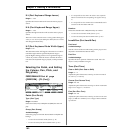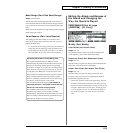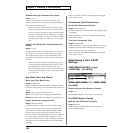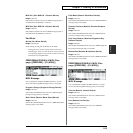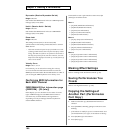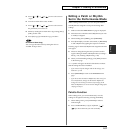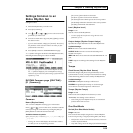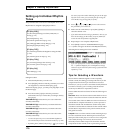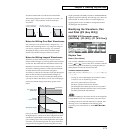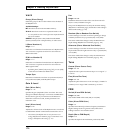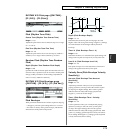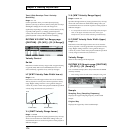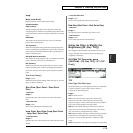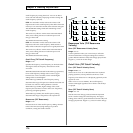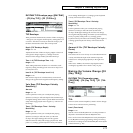
170
Chapter 6 Creating Rhythm Sets
Setting up Individual Rhythm
Tones
The parameters that can be set for each Rhythm Tone of the
Rhythm Set are assigned to [F2]–[F5] as follows.
Setting Procedure:
1. Select the Rhythm Set you wish to set.
2. Press [F2]–[F5], whichever has the parameter you wish to
set assigned to it, and select the display group.
With some display groups, you then press [F1]–[F4] to access
the desired page.
3. Press Tone Select [1]–[4] to select the percussion
instrument sound you wish to edit, according to the key
that plays it.
TONE SELECT [1]: Selects the key one octave below the
currently selected key.
TONE SELECT [2]: Selects the key a semitone below the
currently selected key.
TONE SELECT [3]: Selects the key a semitone above the
currently selected key.
TONE SELECT [4]: Selects the key one octave above the
currently selected key.
* You can also press a key on a connected MIDI keyboard to
select the desired percussion instrument sound (key). (p. 168)
* By holding down [SHIFT] and pressing [ ], you can have
the cursor jump to the number indicating the part in the upper
left of the screen. Here, you can switch parts by turning the
VALUE dial, or by pressing [INC] or [DEC].
4. Press [ ]/[ ]/[ ]/[ ] to move the cursor to
the parameter you want to set.
5. Either turn the VALUE dial, or press [INC]/[DEC] to
select the desired value.
* If you make a mistake when setting a parameter’s value, or you
don’t like the change you have made, just press [UNDO] to
restore the value the parameter originally had.
6. Repeat steps 2–5 to complete a Rhythm Set.
7. Press [EXIT] to return to the RHYTHM PLAY page.
A “*” symbol will appear at the left of the Rhythm Set name,
indicating that its settings have been modified.
fig.06-003.e_70
* If you turn off the power or select another Rhythm Set while
the “*” symbol is displayed, your new Rhythm Set settings
will be lost. If you wish to keep these settings, perform the Save
operation. (p. 194)
Tips for Selecting a Waveform
Because the XV-5080 is designed to create completely
realistic sounds, the editing process depends heavily on the
complex PCM waveforms upon which Tones are based.
Therefore, if you try to create a sound that is totally different
from the waveform(s) you’re working with, the desired
result may be difficult or impossible to achieve.
The XV-5080’s internal waveforms fall into the following two
groups.
One-shot: These waveforms contain sounds that have short
decays. A one-shot waveform records the initial rise and fall
of its sound. Some of the XV-5080’s one-shot waveforms are
sounds that are complete in themselves, such as percussive
instrument sounds. The XV-5080 also contains many other
one-shot waveforms that are elements of other sounds. These
include attack components such as piano-hammer sounds
and guitar fret noises.
Looped: These waveforms include sounds with long decays
as well as sustained sounds. With looped waveforms, the
latter part of the sound plays over and over for as long as the
note is held, allowing wave memory to be used more
efficiently. The XV-5080’s looped waveforms also include
components of other sounds, such as piano-string resonant
[F2 (Key WG)]
[F1 (WG Prm)] Selecting waveforms, FXM, Pan, or
Tuning (p. 171)
[F2 (Pitch)] Pitch (p. 173)
[F3 (Pch Env)] Pitch Envelope (p. 173)
[F4 (V.Range)] WMT Velocity Range (p. 174)
[F5 (Sample)] Sample Edit (p. 174)
[F3 (Key TVF)]
[F1 (TVF Prm)] modifies the brightness using the filter
(p. 175)
[F2 (TVF Env)] TVF envelope (p. 177)
[F4 (Key TVA)]
[F1 (TVA Prm)] Changes the volume (p. 177)
[F2 (TVA Env)] TVA envelope (p. 178)
[F5 (Key Ctl)]
Other Settings (p. 179)



